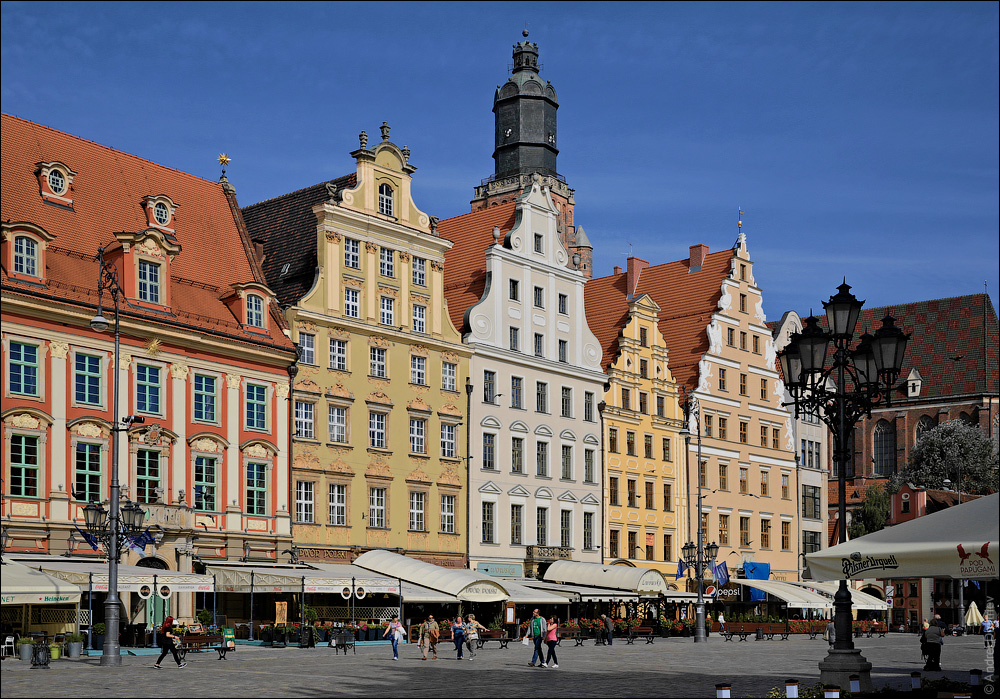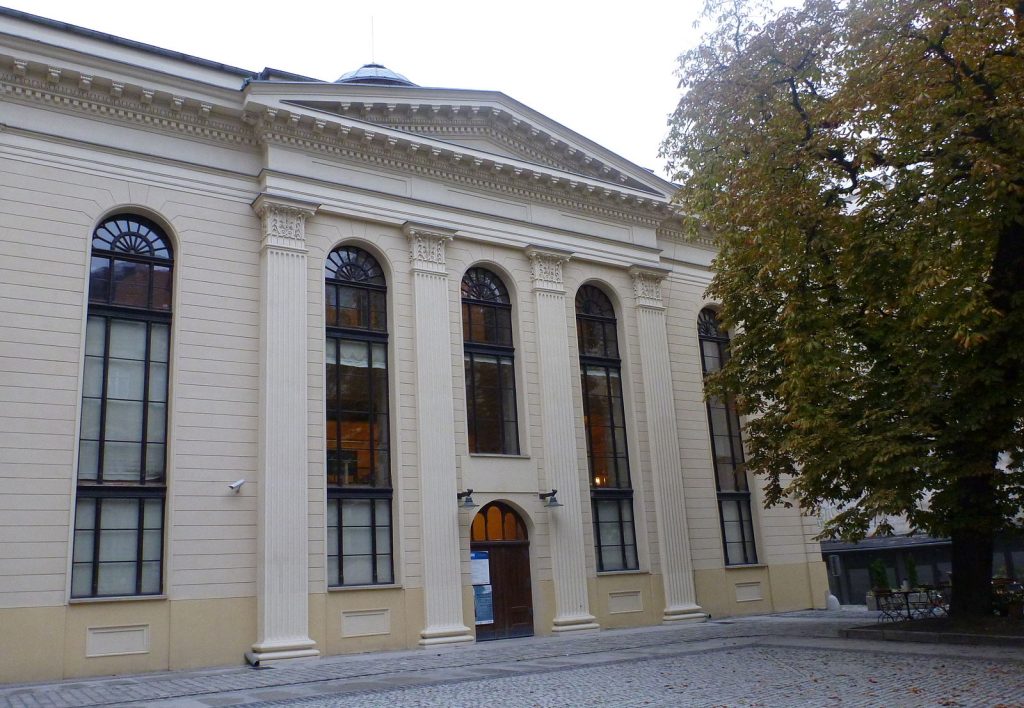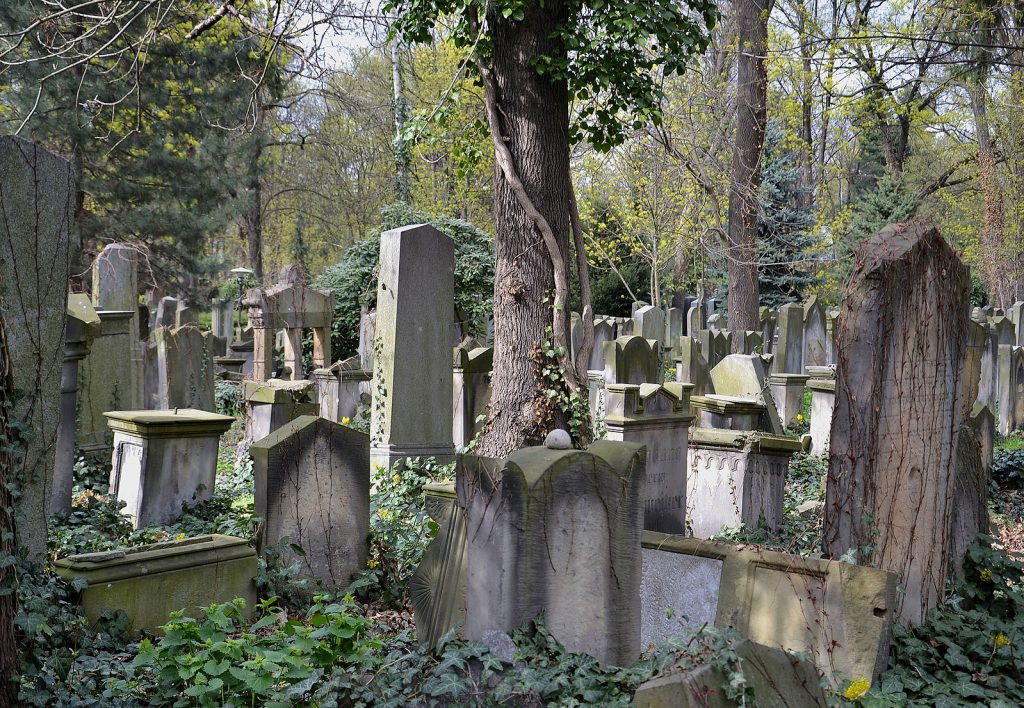
The oldest Jewish tombstone found in Wroclaw (Breslau) dates back to 1203, indicating that by then Wroclaw was home to a permanent Jewish community. In 1290, Wroclaw had the second largest Jewish community in East Central Europe, after Prague. The Jews of the city worked primarily as moneylenders and traders; a smaller minority worked as artisans.
During the 14th century, however, the Jews of Wroclaw were the victims of a number of outbreaks of violence. After a pogrom in 1349, about 5 families remained of the original seventy. 41 Jews were put on trial and burned at the stake in 1453 after being accused of host desecration. That same year, the Jewish community was expelled. Two years later the town was granted an official status of intolerance; Jews were forbidden to live in Wroclaw until 1744 and could only visit during the annual fairs.
In 1741 the city was annexed by Prussia, and in 1744 Frederick II allowed Jews to form an official community there. The Jewish population grew rapidly. In 1747 there were 532 Jews living in Wroclaw (1.1% of the total population); by 1810 that number had jumped to 3,255 (5.2%).

Wroclaw became an important center for the Haskalah (the Jewish Enlightenment). Both communities -the orthodox and the liberal- were active in the religious and cultural lives of the Jews of the city, and were led by distinguished rabbis and scholars. The number of Jewish residents in the city was 19,743 in 1900, and 10,300 in 1939.
In November, 1938 Jewish cultural, social, and educational activities were halted and synagogues and Jewish schools were destroyed during the Kristallnacht pogroms.
Beginning in September 1941, Jews were driven from their homes and property and crowded into “Judenhaeuser” to be deported a few months later to transit camps on the way to Auschwitz. Between November 1941 and the summer of 1944, the Jews of Lower Silesia, including those from Wroclaw, were deported in 11 transports. The first transport took the Jews to Kaunas, where everyone was shot. Subsequent transports sent the Jews to the death camps of Sobibor, and Belzec, or the concentration camps Terezin and Auschwitz. Some Jews were sent to temporary labor camps. By 1943, only partners of mixed marriages and some children remained in the city. The last 150 Jews of the city were deported to Gross-Rosen in January 1945 where they were killed. The old cemetery, which had been founded in 1761, was destroyed.
Beginning in May 1945, Wroclaw was a transit center for Jewish survivors returning from concentration camps in Silesia and Poland. Jews from former Polish territories that had been annexed to the Soviet Union during the war began arriving in the city in waves beginning in 1946, making Wroclaw the largest Jewish community in Poland. Though the number of Jews in Wroclaw rose to 17,747 in 1946, after the pogrom in Kielce in July of that year the numbers dropped considerably; by the spring of 1947 there were about 15,000 Jews living n Wroclaw.
The postwar Jewish community attempted to rebuild and established a religious community, schools, Jewish cooperatives, and a Jewish theater, as well as other organizations and political parties. The population continued to drop, largely as the result of emigration, and by 1960 there were 3,800 Jews left in the city. The Six Day War and anti-Semitism led to a marked increase in emigration after 1967. This led to the closing of the Jewish school and theater. In 1974 there were 3,000 Jews in Wroclaw.
A Jewish revival began during the late 1980s. In the year 2000, the city reopened the Jewish Social-Cultural Society, and was home to a Jewish school. The White Stork Synagogue, which had been used by the Nazis as an auto repair shop and to store stolen Jewish property, was rededicated in 2010 after a full-scale restoration.
As of 2014, there were 350 registered members of the Jewish community in Wroclaw, making it the second-largest organized Jewish community in Poland, after Warsaw.
The remains of what appears to be a 14th-century synagogue appear to have been found in Wroclaw in 2021. The discovery was made during renovation work on a building near the Historical Institute of the University of Wrocław, on 49 Szewska Street.
When visiting Wroclaw, you may pass by what was once the city’s magnificent main synagogue – torched on Kristallnacht (November 9, 1938). A small memorial remembering where it once stood is located at ul. Łąkowa 6.
The only synagogue in Wrocław to escape the torches of Kristallnacht, the White Stork was built in 1829, taking its name from the inn that once stood in its place. Following the design of prominent German architect Karl Ferdinand Langhans, it is ironically considered a sterling example of 18th-century Protestant sacral art. Discreetly hidden from view in a courtyard, it was here that members of the Jewish community were rounded up for deployment to the death camps during WWII. Badly damaged but not set ablaze (thanks only to its proximity to residential buildings), the synagogue was literally left to rot after the war, before the Jewish community was finally able to recover it from the Polish government in 1996 and initiate restoration. Reopened in May 2010, the synagogue now serves as a worship space, cultural centre, and branch of the Jewish Information Centre, with a new multi-functional hall in the synagogue’s basement, two exhibition spaces on the balconies (one houses a permanent exhibition about the history of Jews in Wrocław and Lower Silesia, while the second is for temporary exhibitions), and a ritual bath that opened in January 2019.
Right next to the synagogue, you will find the Bente Kahan Foundation, which organises monthly events, including exhibitions, film screenings, workshops, lectures, concerts, theatre performances, and more. There is another Jewish cultural center on the same street : After renovations, the Jewish Information Centre has reopened as CIŻ Cafe – a kosher coffeehouse, bookshop, and tourist info centre. In addition to being a new venue for Jewish-related lectures, workshops, and other events, this outfit also arranges Jewish walking tours of Wrocław. While you’re there, enjoy Middle Eastern snacks and the all-day breakfast. Note that this Jewish center also edits the Jewish-Polish magazine Chidusz.

Established in 1856, the old Jewish cemetery is perhaps the most well-preserved testament to the former strength of Wroclaw’s pre-war Jewish community, with over 1200 gravestones. Closed in 1942, the cemetery quickly fell into deep neglect: in 1945 it was turned into a fortress by the Nazis and saw fierce fighting as evidenced by the eerie bullet holes in many of the gravestones. Preservation began in the 1970s and in 1991 it was opened as the Museum of Jewish Cemetery Art in tribute to the craftsmanship of its sepulchral art. Indeed, the beauty and diversity of styles and symbols on display is perhaps unmatched anywhere. Many noteworthy figures are buried here, including the historian Heinrich Graetz, Ferdinand Lassalle. Using old records, some of their tombstones are slowly being restored. However, despite these modest efforts, the Ślężna Street Cemetery remains a wild sanctuary. Well worth a visit, a highly informative accompanying booklet (in Polish, English or German) makes it even more so, despite being overpriced at 15zł.
Located northwest of the centre, the New Jewish Cemetery was founded in 1902 when the Ślężna Street cemetery became too small, and is still in use by Wrocław’s Jewish community today. That hasn’t saved it from the ravages of time, however, and like the cemetery it succeeded, it stands in sharp contrast to the well-kept Catholic cemeteries across Poland. Comprising 11 hectares and approximately 8,000 graves, this is the fifth largest Jewish cemetery in Poland. Likewise registered as a historical monument for its rich diversity of aesthetic and architectural styles, the most noteworthy tomb here is dedicated to the Jewish soldiers of the German Army who fought and died in WWI; their 432 names are etched into the top of the monument. The cemetery is currently the subject of slow renovation work and is only open to the public from May 1st to October 30th, on Wednesdays (14:00 – 17:00) and Sundays (09:00 – 13:00), with parts of the cemetery cordoned off altogether. Still, about 80% is accessible, with about 50% having already undergone restoration. To get there, catch trams 10, 33, 20 or 3 from Pl.Jana Pawła II and get off at ‘DH Astra;’ it’s about a 12-minute ride.
Sources : Beit Hatfutsot online database ; In Your Pocket